TL;DR
2025’s Scandinavian interiors trend leans tactile and tonal: monochrome bedrooms, natural-fiber bedding, sculptural headboards, and softened color stories. Expect fewer pieces, better materials, and thoughtful layers—exactly how to design a monochrome bedroom with texture.
What Makes Scandinavian Textiles the Defining Home Design Trend of 2025?
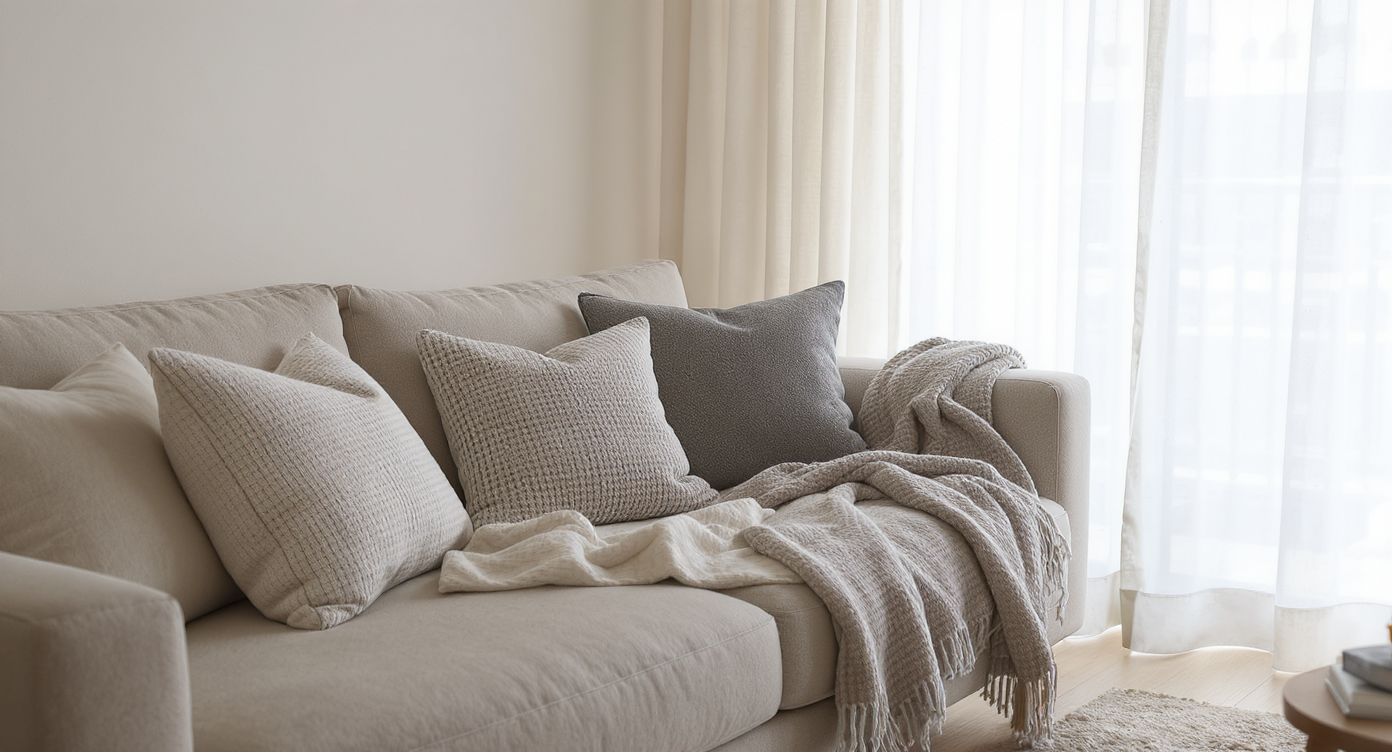
Textile layering in Scandinavian living rooms balances comfort and subtle pattern for natural warmth.
Scandinavian textiles are steering 2025 home design toward calm, comfort, and craft. Think monochrome bedroom schemes, natural-fiber bedding, sculptural headboards, and curtains that filter light like morning mist. The result is a tactile form of quiet luxury—less about logos, more about how fabric feels against the skin and how color settles in a room.
Here’s the thing: the Scandinavian look isn’t just a style. It’s a system. Designers talk in terms of uniform, not uniformity—one grounding color across the room, then precise layers for depth. This mindset respects real life. It welcomes a wool-cashmere throw on the sofa, Egyptian cotton sheets on the bed, and a patterned cushion that whispers, not shouts.
Trend Overview
Across top Scandinavian studios, three threads unite the season: tactility, tonality, and longevity. Materials lead—cotton, wool, linen—then form supports with soft geometry and tailored upholstery. Color remains restrained but not shy: clay reds, tobacco browns, moss greens, and oat neutrals add atmosphere without stealing the scene.
Search trends point to rising interest in Scandinavian textiles, monochrome bedroom ideas, and natural fiber curtains. Homeowners want rooms that feel composed, not contrived—high-thread-count sheets, linen bedspreads with weight, and rugs that ground a space visually and acoustically. Experts note that rooms with fewer, better textiles age more beautifully and need less seasonal overhaul.
Anecdote
A couple trading bright-white bedding for mushroom percale and a single brick-red throw said the room finally felt like them—soft, warm, and unforced.
Monochrome Rooms: The Scandinavian Bedroom Uniform
Monochrome bedrooms are trending because a single hue creates instant calm and a cohesive canvas for subtle layers. Designers often advise a 60-30-10 approach: 60% dominant tone, 30% supporting tone, 10% accent.
The idea is simple: dress the room in one color family—walls, bedding, curtains—then layer in texture and a restrained accent. Oatmeal linen with biscuit paint, or charcoal bedding with graphite curtains. This strategy quiets visual noise and amplifies material richness. A monochrome bedroom also photographs larger; reducing contrast helps walls recede and textiles read as a serene whole. As a rule of thumb, keep undertones consistent—warm with warm, cool with cool—to prevent mismatched grays and beiges. A soft brick-red throw, for example, can warm a taupe scheme without hijacking the view.
How to Bring It Home
- Pick a base: warm taupe, chalk white, or soft mushroom are 2025 favorites.
- Keep accents under 10%—one patterned cushion or a single wood tone is enough.
- Use matte paint or limewash to echo the softness of textiles.
Touch-First Textiles: Natural Fibers, Quiet Luxury
Natural fiber bedding and throws dominate this year because touch matters daily; experts recommend 300–500 thread count for percale and 300–600 for sateen, depending on feel preference.
The Scandinavian approach prizes materials you’ll love living with: Egyptian cotton percale for crisp breathability, sateen for a subtle sheen, wool-cashmere blends for warmth without weight, and dense-weave linen for that graceful, lived-in drape. Designers often note that avoiding synthetics reduces static, pills less over time, and regulates temperature better. If you run warm, percale’s matte structure promotes airflow; if you prefer cozy, sateen’s tighter weave hugs the body. For durability, many pros suggest investing in core sets in neutral hues and rotating decorative pillowcases seasonally.
How to Bring It Home
- Bedding basics: two sheet sets, four pillowcases, one duvet cover—rotate weekly for longevity.
- Curtain fullness should be 1.5–2 times the window width for elegant drape.
- Choose wool or wool-blend throws between 300–500 gsm for year-round use.
Soft Geometry: Sculptural Headboards & Upholstery
Curved headboards and rounded upholstery are surging as a counterpoint to hard lines; designers say a gentle radius reads restful and modern at once.
Picture a headboard with a clean profile—straight edge, softened corners—or a crown shape with a timeless arc. These forms nod to Scandinavian restraint while adding sculptural interest. Beyond looks, proportion is key: aim for a headboard 2–4 inches wider than your mattress and 48–54 inches high for a queen. In living rooms, radius-arm sofas and pebble-shaped ottomans deliver the same softness. When textiles lead, shapes should support—quiet curves, tailored seams, nothing fussy. Upholstery in wool bouclé, cotton velvet, or tightly woven linen wears well and feels luxe to the touch.
How to Bring It Home
- Match curvature: pair a rounded headboard with a dome bedside lamp or soft-edged nightstand.
- Use contrast piping to define gentle shapes without heavy lines.
- Anchor curves with a square rug or rectilinear bench for balance.
Muted Color Saturation: Layered Reds, Neutrals, and Woods
Muted reds and earth-greens are returning in softened tones because saturated yet softened color adds character without visual fatigue. Experts recommend testing reds with a touch of brown or gray to blend with neutrals.
In practice, that means swapping a bright cherry throw for a brick, oxblood, or sienna cashmere blend. Red, when dulled slightly, reads like a warm neutral and complements oak, walnut, and travertine. Try one accent across the room—throw, cushion, or bedspread—not all three. A useful ratio: one color statement per small room, two in larger spaces. Woods carry the palette too: honey oak and smoked walnut harmonize with warm linens and tobacco leathers, creating a cocoon without gloom.
How to Bring It Home
- Test swatches in morning and evening light; cool daylight can sharpen red, warm LEDs will soften it.
- Limit patterns to one piece—leopard, stripe, or floral—so texture stays center stage.
- Echo the accent color once elsewhere, like a spine of books or a ceramic vase.
Heritage Craft, Modern Circularity
Scandinavian design’s newest chapter pairs heirloom techniques with innovative, low-waste materials; many studios are reworking offcuts and reviving archival patterns.
Expect hand-woven motifs translated into bedspreads, artisanal glassware alongside stone and bronze objects, and furniture using stone waste or recycled composites. Designers often advise investing where touch is constant—bedding, curtains, upholstery—then punctuating with one functional art piece. For rugs under beds, a simple sizing rule helps: an 8×10 rug fits a queen with nightstands, while 9×12 suits a king. Craft, when scaled correctly, feels intentional—not precious—and supports everyday living.
How to Bring It Home
- Buy fewer, better: one artisan item per room creates focus and curbs clutter.
- Seek repairable goods—zippered cushion covers, replaceable rug pads, washable slipcovers.
- Mix eras thoughtfully: pair modern linen with a vintage wood nightstand for texture contrast.
Trend Crossovers & Contrasts
Though each trend feels distinct, they share a return to texture, craft, and a sense of restraint. Soft geometry balances the tailored feel of monochrome rooms; muted reds and deep woods warm pale linens; natural fibers ensure every layer earns its place.
Across the board, the Scandinavian palette favors warm neutrals, tactile weaves, and materials with provenance. The mindset is consistent: reduce visual noise, heighten sensory pleasure, and choose pieces that age well. The crossover? A home that reads modern and feels human.
What People Often Get Wrong About 2025 Design Trends
- Mistaking monochrome for monotony—vary weave, sheen, and pile so a single hue still has depth.
- Choosing thread count over quality—fiber and weave matter as much as numbers; 300–500 percale is often ideal.
- Over-layering color accents—cap yourself at one statement hue per small room to keep calm energy.
- Ignoring scale with curves—pair rounded pieces with one strong rectilinear element for structure.
- Flat curtains—use 1.5–2× fullness and hang 4–6 inches above the frame to visually raise ceilings.
Visualization Scenario
Use ReimagineHome to render a taupe-on-taupe bedroom with a curved headboard, brick-red throw, linen drapes at 2× fullness, and a 9×12 rug under a king bed.
FAQ
How do I design a monochrome Scandinavian bedroom that isn’t boring?
Use one color family and vary texture: percale sheets, linen curtains, wool throws. Keep a 60-30-10 ratio and limit accents to one piece.
What thread count is best for Scandinavian percale bedding?
Most experts recommend 300–500 thread count for percale; focus on long-staple cotton and weave quality over higher numbers.
How high should a headboard be for a modern Scandinavian look?
For a queen bed, 48–54 inches high feels proportional; keep the headboard 2–4 inches wider than the mattress.
How do you layer muted red in a neutral room without overpowering it?
Choose softened reds with brown or gray undertones and use one statement item—like a throw or cushion—then echo it once elsewhere.
What’s the right curtain fullness for soft, Scandinavian drape?
Plan for 1.5–2× window width and mount curtains 4–6 inches above the frame to elongate the wall and diffuse light gracefully.
Expert Insights & Mini-Anecdotes
“Let materials do the talking,” designers often say. Prioritize the textiles you touch daily—sheets, towels, upholstery—and let accents come second.
A homeowner I visited swapped mismatched bedding for a mushroom-toned percale set and one oxblood throw. The room exhaled; sleep improved simply because the textures felt calmer and the color story was coherent.
Another client hung sheer linen curtains with 2× fullness across a narrow window. The light turned milky and soft, and the room looked half a meter wider. Small math, big impact.
In a studio makeover, we traded a boxy headboard for a rounded crown silhouette and added a square jute rug. The curve softened, the square grounded—proof that shape dialogue matters as much as color.
Tools, Resources & Visualization
Test these ideas before you buy. With ReimagineHome, you can visualize a monochrome bedroom, compare percale vs. sateen on the bed, and drop in a sculptural headboard to check proportions. Try filters for warm neutrals, add a brick-toned throw, and preview sheer vs. blackout curtain opacity.
Picture this: a quiet bedroom layered in warm taupe, sheets crisp and cool to the touch, a rounded headboard catching morning light, and a softened red throw at the foot of the bed. That’s Scandinavian serenity—tailored, tactile, timeless.
Wrap-Up
In 2025, Scandinavian design isn’t about perfection—it’s about presence. Monochrome rooms calm the eye, natural fibers soothe the skin, curves relax the silhouette, and softened color brings soul. Choose less, choose better, and let your textiles tell the story of how you live—today, and ten years from now.
.svg)

.svg)
.jpg)
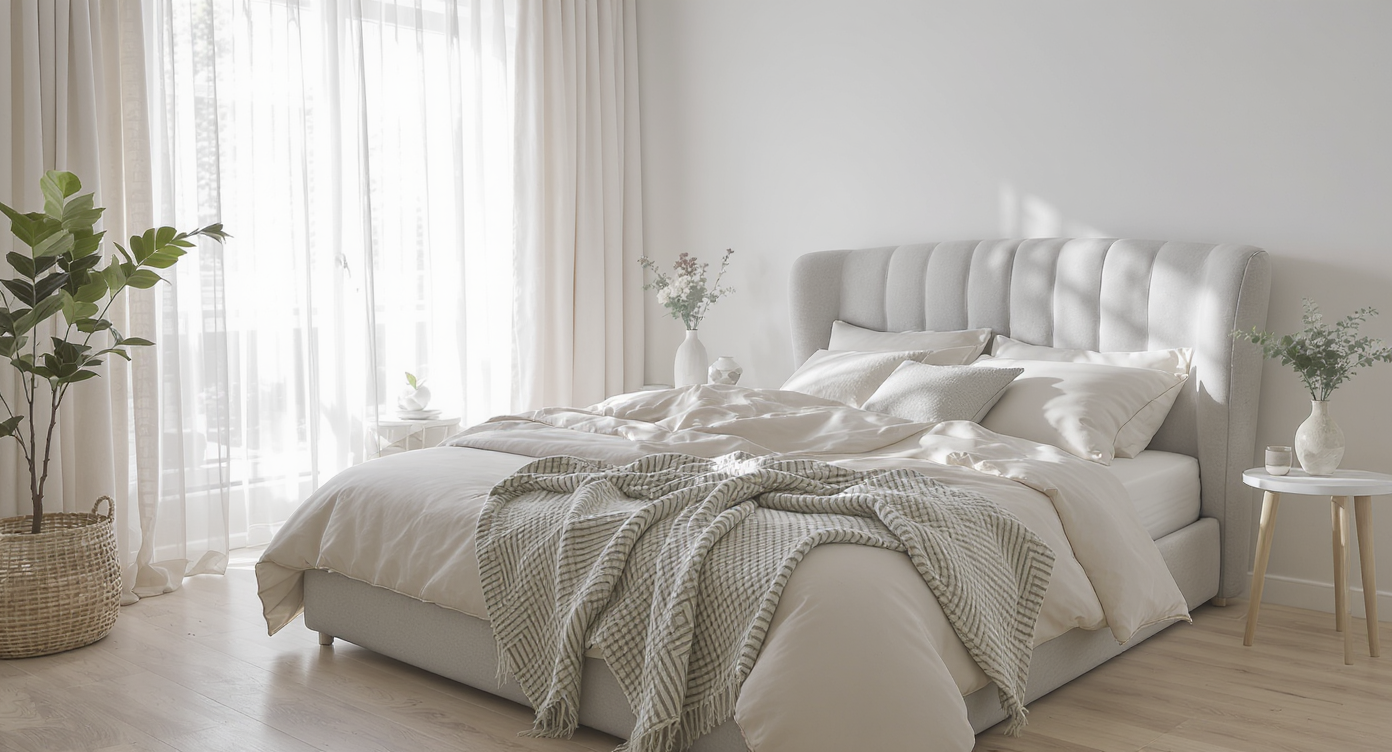




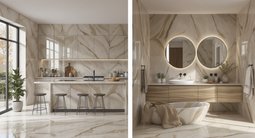
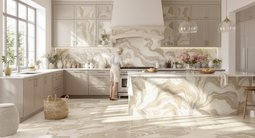



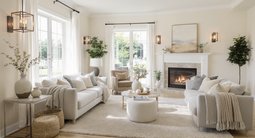


.png)